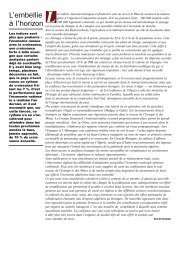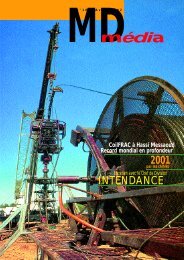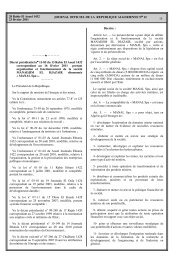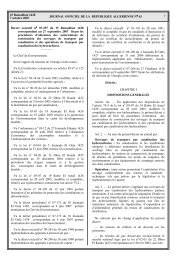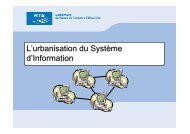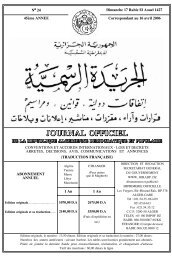Full issue - Ministère de l'énergie et des mines
Full issue - Ministère de l'énergie et des mines
Full issue - Ministère de l'énergie et des mines
You also want an ePaper? Increase the reach of your titles
YUMPU automatically turns print PDFs into web optimized ePapers that Google loves.
ELECTRICITY ELECTRICITY TRANSPORTATION<br />
☞<br />
Energie & Mines<br />
38<br />
Regardless of the type of mark<strong>et</strong>, we<br />
find certain constants. This concerns :<br />
■ Third party access to the n<strong>et</strong>work<br />
■ The benchmark price<br />
■ The existence of a regulator<br />
■ The in<strong>de</strong>pen<strong>de</strong>nce of the n<strong>et</strong>work’s<br />
management (compared to the<br />
actor(s))<br />
■ The scope (link with the System<br />
Operator)<br />
As a rule of thumb, two large types of<br />
mark<strong>et</strong> dominate :<br />
■ The “Pool” type mark<strong>et</strong>s<br />
■ The “Stock” type mark<strong>et</strong>s<br />
Of course, <strong>de</strong>pending on the experience<br />
of each involved, and the specificities<br />
of a country within the same type,<br />
we find several variations :<br />
■ The “Pool” type mark<strong>et</strong>s: Bond mark<strong>et</strong>s<br />
– these types of mark<strong>et</strong>s are mainly<br />
found in North America (PJM, XX-<br />
ISO, <strong>et</strong>c.), in Australia, in Spain and in<br />
the UK – first version. These last two<br />
countries are in the middle of changing<br />
and are moving towards “Stock” type<br />
mark<strong>et</strong>s.<br />
■ The “Stock” type mark<strong>et</strong>s: Voluntary<br />
mark<strong>et</strong>s – these are so-called “Spot”<br />
mark<strong>et</strong>s, particularly in Europe (APX,<br />
PowerNext, <strong>et</strong>c.)<br />
■ In both types of mark<strong>et</strong>, specific<br />
transactions b<strong>et</strong>ween players may be<br />
ma<strong>de</strong>; these are bilateral contracts or<br />
OTC (Over The Counter) contracts.<br />
Before making a brief <strong>de</strong>scription of<br />
how these mark<strong>et</strong>s operate, we need to<br />
point out :<br />
■ Today, and due to the experience gained,<br />
the ten<strong>de</strong>ncy is towards <strong>de</strong>veloping<br />
“Stock” type mark<strong>et</strong>s. A lot of<br />
“Pool” type mark<strong>et</strong>s are in the process<br />
of changing towards the “Spot” type.<br />
■ The role of the Electricity Mark<strong>et</strong>s is<br />
not to "lower” the prices of energy, as is<br />
the custom to think, but to give a<br />
benchmark price for energy, which<br />
enables the different players to be able<br />
to position themselves. This is why, in<br />
this type of mark<strong>et</strong>, <strong>de</strong>aling with 5 to<br />
10% of the total energy which circulates<br />
in a n<strong>et</strong>work is amply sufficient.<br />
Nevertheless, we will always look for a<br />
greater mark<strong>et</strong> share insofar as it<br />
increases turnover and adds more credibility<br />
to this mark<strong>et</strong>.<br />
november 2005<br />
Regardless of the type of mark<strong>et</strong>, it is<br />
essential for two elements to be present :<br />
■ A measurement system (quick, reliable,<br />
automatic and accepted) for the<br />
energy produced or consumed by each<br />
player involved in the mark<strong>et</strong>.<br />
■ Capacities to succeed in the liquidations<br />
of transactions b<strong>et</strong>ween the<br />
players (role which is very often <strong>de</strong>volved<br />
to the Mark<strong>et</strong> Operators). In the<br />
case of our country, the problem of the<br />
banking system’s performance will be<br />
surely posed as a precursor to a performing<br />
mark<strong>et</strong> system.<br />
As a rule of thumb, all these mark<strong>et</strong>s<br />
are based on simple rules in their operating<br />
and strict rules in their application.<br />
No interference outsi<strong>de</strong> the mark<strong>et</strong><br />
and outsi<strong>de</strong> its rules is accepted.<br />
The regulators, when they exist, supervise<br />
these questions. We may cite the<br />
main ones :<br />
■ Total transparency: all the transactions<br />
will be ma<strong>de</strong> clearly, and can be fully<br />
audited – a posteriori – if necessary.<br />
■ Impartial neutrality of the body responsible<br />
for the operating of the mark<strong>et</strong>, i.e.<br />
the Mark<strong>et</strong> Operator with, as a corollary,<br />
strict respect of confi<strong>de</strong>ntiality.<br />
The latter, in the opinion of a lot of<br />
experts, is a critical point which must be<br />
guaranteed at any price. Confi<strong>de</strong>ntiality<br />
does not only concern the Mark<strong>et</strong><br />
Operator, but also the other structures<br />
such as the Manager of the n<strong>et</strong>work and<br />
the System Operator.<br />
■ Equality and Equity of treatment, with<br />
no player having a dominant position or a<br />
capacity to disrupt the mark<strong>et</strong>.<br />
■ The obligation to strictly respect the<br />
commitments: i.e. existence of sufficiently<br />
clear and fully comprehensive operating<br />
rules, as well as a guarantee system<br />
enable all the transactions to be purified<br />
which are ma<strong>de</strong> in the mark<strong>et</strong>.<br />
All the mark<strong>et</strong>s – in particular the most<br />
current ones: Day Ahead Mark<strong>et</strong> – operate<br />
according to the principle of the<br />
fixing :<br />
■ Bids and offers are expressed by the<br />
mark<strong>et</strong> players <strong>de</strong>pending on a very<br />
precise timing and for each maturity.<br />
■ At the close of offers, we <strong>de</strong>termine<br />
the price of energy for the maturity:<br />
this is the fixing.<br />
■ All the offers to the left of the fixing<br />
point are r<strong>et</strong>ained, and the others are<br />
exclu<strong>de</strong>d.<br />
■ The mark<strong>et</strong> prices are displayed - this<br />
is the benchmark price.<br />
On the other hand, if we consi<strong>de</strong>r the<br />
overall operating of the electric system,<br />
the mark<strong>et</strong>s have to offer other services,<br />
the most important of which are :<br />
■ The balancing mark<strong>et</strong>s.<br />
■ The n<strong>et</strong>work losses’ mark<strong>et</strong>s – essential<br />
for the n<strong>et</strong>work managers who find<br />
a means here of minimising the costs of<br />
the energy consumed by the n<strong>et</strong>work<br />
which they are responsible for.<br />
■ The reserve mark<strong>et</strong>s necessary for<br />
the equilibrium of the Productionconsumption<br />
system.<br />
■ The “black start” services.<br />
■ …<br />
■ And now, the so-called "Futures"<br />
mark<strong>et</strong>s, i.e. the future weeks and<br />
months mark<strong>et</strong>s.<br />
The operating of these so-called secondary<br />
mark<strong>et</strong>s – may be done according<br />
to the principle of the fixing or according<br />
to other principles; for example:<br />
the PAB (Pay As Bid).<br />
The mark<strong>et</strong> Operator<br />
This is the structure which is responsible<br />
for the operating of the electricity<br />
mark<strong>et</strong>. It is, generally, a private company<br />
and/or a company having sufficient<br />
in<strong>de</strong>pen<strong>de</strong>nce in relation to the<br />
mark<strong>et</strong> players and other bodies.<br />
It must have the following essential<br />
characteristics :<br />
■ Total in<strong>de</strong>pen<strong>de</strong>nce from the mark<strong>et</strong><br />
players or any other supervisory body.<br />
■ Guarantee perfect confi<strong>de</strong>ntiality on<br />
the mark<strong>et</strong> transactions.<br />
■ Strictly respect the mark<strong>et</strong> rules.<br />
■ Not itself be a player in this mark<strong>et</strong>:<br />
principle of neutrality.<br />
Its role consists of :<br />
■ Coordinating the mark<strong>et</strong>: registering<br />
the mark<strong>et</strong> players<br />
■ Receiving offers<br />
■ D<strong>et</strong>ermining the fixing (MCP :<br />
Mark<strong>et</strong> Clearing Price)<br />
■ Controlling the execution of mark<strong>et</strong><br />
or<strong>de</strong>rs<br />
■ Liquidating the transactions ma<strong>de</strong> on<br />
the mark<strong>et</strong><br />
■ Offering other mark<strong>et</strong> services<br />
To fulfil this role, the Mark<strong>et</strong> Operator<br />
may have :<br />
■ Means of communication and<br />
exchanges of information with the dif-




